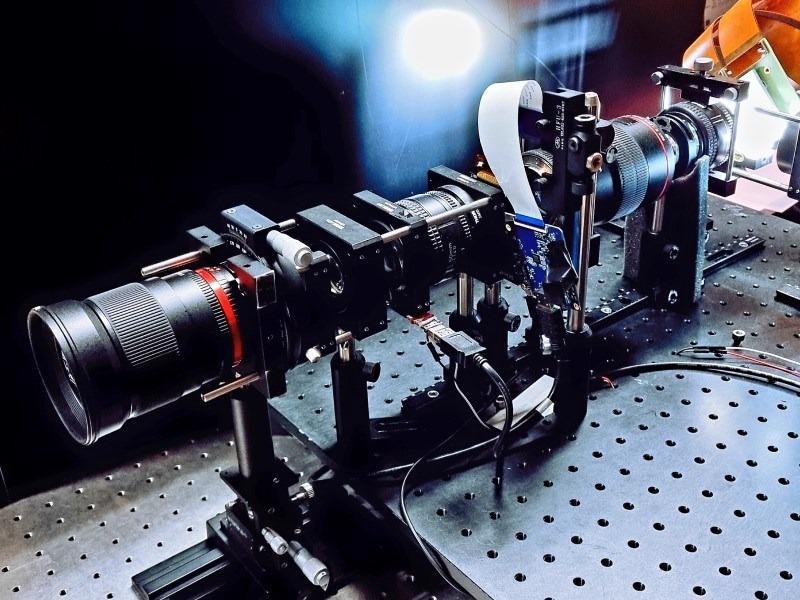Reviewed by Alex SmithAug 25 2021
Researchers have built a prototype display that works on projection to generate large-scale 3D images with ultra-high definition. The new technique resolves the challenges in light-field projection.
 Researchers combined two different light field display technologies to project large-scale 3D images with almost diffraction-limited resolution. Their optical setup is shown. Image Credit: Byoungho Lee, Seoul National University.
Researchers combined two different light field display technologies to project large-scale 3D images with almost diffraction-limited resolution. Their optical setup is shown. Image Credit: Byoungho Lee, Seoul National University.
Thus, the new technique helps to generate natural-looking 3D images that do not need special 3D glasses for viewing.
Our optical design could make it practical to replace 2D flat panel displays with 3D images for digital signs, entertainment, education and other applications where 3D images provide a significant enhancement. Our design could also be modified to provide immersive experiences in movie theaters, for example.
Byoungho Lee, Research Team Leader, Seoul National University
In the study, the researchers explain the procedure by which two different light-field display technologies were combined to project large-scale 3D images with almost diffraction-limited resolution. The newly developed display is autostereoscopic; in other words, it generates different 3D images enabling a view from various angles. The study was published in the journal Optics Letters.
We developed a way to carry out all the display processes optically without any digital processing. This compensates for the limitations of each display technology to allow the creation of high-resolution 3D images on a large screen.
Byoungho Lee, Research Team Leader, Seoul National University
Combining Technologies
Light-field displays operate by reproducing the reflected light from an object, corresponding to the actual visible position. The autostereoscopic light field displays tend to produce different images for different viewing angles. This creates the requirement for a large amount of data to be processed.
Such requirements cause a tradeoff between the size of the displayed image and the resolution. This is because the hardware of the display gets overwhelmed by the quantity of data required.
To resolve this problem, the researchers developed a new optical configuration that merges a multifocal display with integral imaging. A multifocal display is capable of creating a high-quality volumetric image. However, it is technically difficult to execute it on a large-screen system. A point also to be noted is that integral imaging is better at enlarging images.
Regarding the new design, the multifocal display produces a high-resolution 3D, or volumetric, scene. Meanwhile, the integral imaging technology enlarges it, enabling it to be viewed on a large screen. The data conversion between the multifocal display and integral imaging is executed optically without any digital processing.
“Our method goes beyond merely combining two existing methods to achieving an ultrahigh-definition volumetric light-field display with almost diffraction-limited resolution. We also found a way to effectively resolve the difficulty of enlarging a volumetric scene and overcame problems with information loss that tend to affect integral imaging,” Lee stated.
Large and High-Resolution 3D Images
Post verification of the resolution of the prototype systems, the researchers qualitatively affirmed the reconstruction of volumetric images. The tests revealed that the prototype was capable of synthesizing a volumetric image of 21.4 cm x 21.4 cm x 32 cm. This is similar to 28.6 megapixels and 36 times greater resolution than the original image.
Our approach is very efficient at processing information, which enables a low computing cost as well as simple, high-quality, real-time system configuration. The optical design can also be seamlessly integrated with various techniques used in existing light-field displays.
Byoungho Lee, Research Team Leader, Seoul National University
The researchers are now engaged in optimizing the optics and decreasing the complexity of the multifocal display to make the projector more compact. The researchers observe this point because the system is a combination of two different technologies.
The performance of the resulting system will probably improve along with the development of each technology.
Journal Reference:
Jo, Y., et al. (2021) Ultrahigh-definition volumetric light field projection. Optics Letters. doi.org/10.1364/OL.431156.